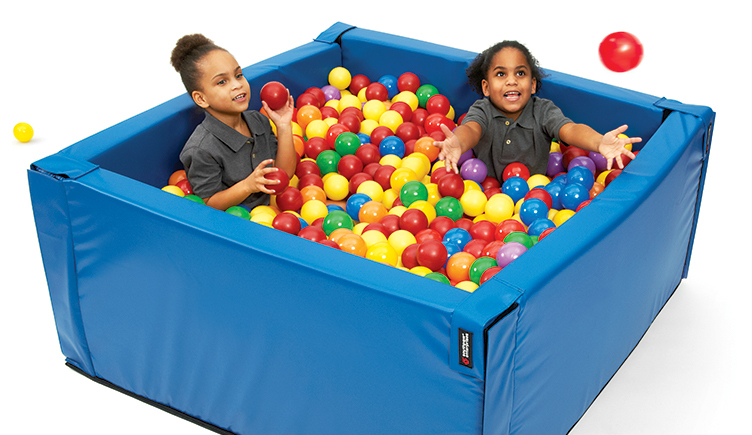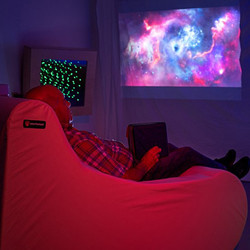Rejuvenating Verland’s Multi-Sensory Environment , or Sensory Room, as dubbed by the Verland therapists, was a project I eagerly dove into about a year ago. The journey started with researching how to effectively and meaningfully impact those with severe to profound intellectual disabilities—the very people Verland serves. Though literature on therapeutic intervention approaches for individuals in this population tends to be scarce, there is notable support for utilizing sensory-enriched environments. With this information in hand, it was easy to find Tom Marshall and Southpaw through a colleague in Pittsburgh. The rest is history, as they say.
Our newly installed Sensory Room, outfitted with equipment that stimulates visual, auditory, tactile, vestibular and proprioceptive senses, is frequented by our residents and therapists anywhere from one to three times a week. Each session focuses on addressing individualized needs, ranging from physical to psychosocial to developmental, in an effort to yield positive outcomes. Results of intervention thus far boast consistent, positive changes in the following areas: active engagement, both cognitively and physically; emotional and affective presentation; use of executive functioning skills, such as initiation, joint attention and monitoring; and carry-over of self-regulation strategies.
Focusing on physical and cognitive engagement in a meaningful and purposeful way is a huge benefit of the Sensory Room, especially in this age of COVID-19. Verland’s Recreational Therapist, Gabby, notices residents ambulate for longer periods of time, leading to improved activity tolerance and strength, when using the controls to manipulate the receivers. Setting up a stimulating, interactive environment positively correlates to a resident’s level of active engagement. Deni, one of Verland’s Speech-Language Pathologists (SLPs), reports that her one-to-one therapy sessions last around 40 minutes inside the Sensory Room, as opposed to 20 minutes outside of the space. This improved tolerance for direct intervention is crucial for skill progression and mastery.
Attending to our residents’ emotional and psychological well-being is a top priority as well. The goal of each session is to associate a positive, person-centered outcome with every experience. Kayla, Verland’s Behavioral Specialist, has found the stereo and vibro-acoustics most beneficial when reaching a resident with neurodegenerative disease. Playing music designed by this resident’s father, while the resident is sitting on his favorite surface, the vibro-acoustic platform, allows him to become engulfed in a holistic, meaningful experience. He presents with relaxed body posturing, positive affect and happy vocalizations throughout. Similarly, Gabby uses guided imagery via projector visuals, sounds of waves crashing on the shore, and a box filled with sand and seashells to encourage another resident to reminisce about her mother who has passed. Whether verbally, emotionally or behaviorally expressed, our residents prove to benefit from such spiritual engagements.
Time spent in the space is an opportunity to direct one’s own exploration of the equipment; it facilitates autonomy and choice. Kayla has observed “a lot of growth of the person in the room,” including building confidence in decision-making and initiating novel social and motor interactions. Deni and Hannah, both SLPs, take advantage of the Sensory Room to encourage circles of communication, active listening, language probing and development. Gabby agrees that sensory exploration leads to increased resident verbalizations, especially when familiar staff are actively present and involved in the experience. She acknowledges that co-treatments with staff help forge a unique relationship between the resident and familiar staff, outside of the more routine direct care interactions.
A final prominent goal is to achieve a resident’s optimal self-regulation so they may successfully engage with people and tasks inside and outside of the Sensory Room. This space has the capability to be highly individualized and controlled to facilitate a safe, predictable environment. Kayla notes carry-over of a resident’s ability to identify his state of arousal and modulation of it. After a couple months’ worth of sessions inside the Sensory Room, this resident now independently removes himself from an over-stimulating environment into a calmer one. When at home, he walks to his bedroom, closes the door, shuts off the lights, and sits on a glider rocker with a blanket. When he re-emerges a few minutes later into the stimulating environment, he presents with fewer proprioceptive and auditory seeking behaviors. This example of learning and skill generalization proves the Sensory Room to be an effective tool yielding therapeutic results.
Overall, therapists and staff have gained appreciation for the power of immersive, sensory-based intervention for our residents at Verland. This dedicated space is a creative outlet for resident exploration and expression; it is both a calming, low-stress environment that enables coping, and a stimulating place of learning and personal growth. The Sensory Room is a versatile intervention tool that we, as therapists, are grateful to have at our disposal.



